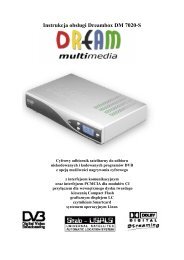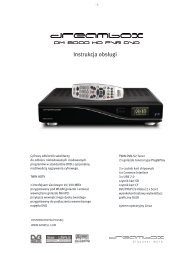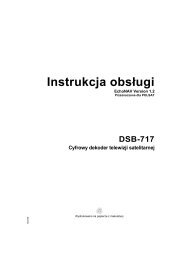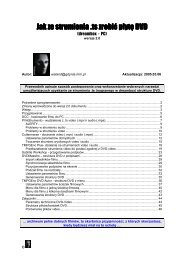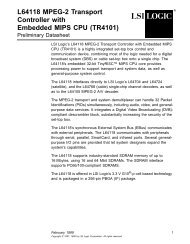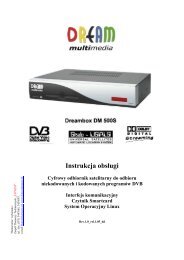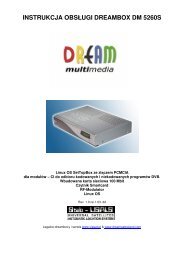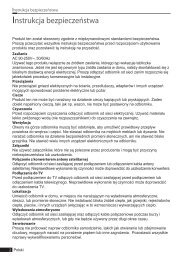Create successful ePaper yourself
Turn your PDF publications into a flip-book with our unique Google optimized e-Paper software.
TS5, <strong>BCT</strong>-<strong>1510</strong>, <strong>BCT</strong>-<strong>1520</strong>,<br />
<strong>BCT</strong>-<strong>1530</strong><br />
•Pin Function (5/5)<br />
The teletext clock and data inputs are shared PIO pins, as shown in Table 15 .<br />
High speed data port pins have a dual function, and can be used either to interface to an external IEEE 1394 link layer<br />
controller or provide an IEEE 1284 parallel port interface.<br />
Pin In/Out Function<br />
1284Data0-7 / AVData0-7 in/out IEEE 1284 port data or AV data<br />
1284notSelectIn in IEEE 1284 port control signals or AV signals<br />
1284notInit / AVPacketTag3 in<br />
1284notFault / AVPacketTag2 out<br />
1284notAutoFd / AVPacketTag1 in<br />
1284Select / AVPacketTag0 out<br />
1284PError / AVByteClkValid out, in/out<br />
1284Busy / AVPacketClk out, in/out<br />
1284notAck / AVByteClk out<br />
1284notStrobe/AVPacketError in<br />
Pin In/Out Function<br />
TDI in Test data input<br />
TDO out Test data output<br />
TMS in Test mode select<br />
TCK in Test clock<br />
notTRST in Test logic reset<br />
PIO pins and alternative functions<br />
To improve flexibility and to allow the STi5512 to fit into different set-top box application architectures, the input and<br />
output signals from some of the peripherals are not directly connected to the pins of the device. Instead they are<br />
assigned to the alternative function inputs and outputs of a PIO port bit. This scheme allows these pins to be configured<br />
as general purpose PIO if the associated peripheral input or output is not required in that particular application.<br />
46<br />
Table 13 High-speed data port pins<br />
Table14TAP pins<br />
Table 17 shows the assignment of the alternative functions to the PIO bits. Parentheses ( ) in the table indicate<br />
suggested or possible pin usages as a PIO, not an alternative function connection.<br />
Port Alternative function of PIO pins<br />
bit PIO port 0 PIO port 1 PIO port 2 PIO port 3 PIO port 4<br />
0 ASC0TxD or SSC0 MTSR ASC2TxD or SSC1 MTSR ASC3TxD<br />
Sc1DataOut<br />
Sc0DataOut<br />
1 ASC0TRxD or SSC0 MRST ASC2RxD or SSC1 MRST ASC3RxD<br />
Sc1DataIn<br />
Sc0DataIn<br />
2 Sc1ClkGenExtClk SSC0 SClk Sc0ClkGenExtClk SSC1 SClk TtxtClockIn<br />
3 Sc1Clk PWMOut0 Sc0Clk CaptureIn0 1284PeriphLogicH/ASC3 CTS<br />
4 (Sc1RST) PWMOut1 (Sc0RST) CaptureIn1 1284HostLogicH/ASC3 RTS<br />
5 (Sc1CmdVcc) ASC1TxD (Sc0CmdVcc) CaptureIn2 Interrupt2<br />
6 (Sc1CmdVpp)<br />
Sc1Dir<br />
ASC1RxD (Sc0CmdVpp) Sc2Dir CompareOut2 Interrupt3<br />
7 (Sc1Detect) PWMOut2 (Sc0Detect) 1284InnotOut TtxtData<br />
Table 15 Alternative function of PIO pins




